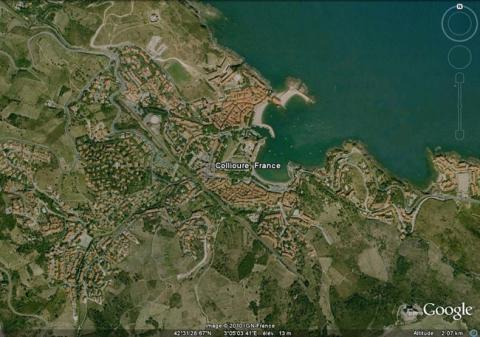Collioure
History and description
Town of Roman origin, Collioure saw its first fortifications built in the wisigothe period, and later reinforced under the Arab occupation. The castle and town were constructed from the 8th century. Transformed multiple times, the castle took on its general shape in the 13th century under the Kings of Majorca. In the 16th century, Charles Quint ordered multiple sets of construction in order to modernise the defences. From 1538, the urban wall was modernised and a hornwork was added to the castle on its north-west side. Two star-shaped forts were also constructed on the outside to reinforce the defence: the fort Sainte-Thérèse on the plateau de Justice, to the north, and the fort Saint-Elme on mont Japone to the south.Taken by the French in 1642, Collioure had its fortifications modified when it was returned against Spain. The fort Sainte-Thérèse was demolished and replaced by the fort du Mirador, situated further to the south. In 1669, other forms of construction were realised on the urban wall and the castle was transformed into a citadel. The marquis and engineer Saint-Hilaire, according to the directives of Vauban, razed the former upper town of Collioure for the construction of the glacis and the new urban wall. The fort Saint-Elme is preserved.
Following the death of Louis XIV, new constructions commenced at Collioure. The fort Carré and the star tower were constructed from 1726 to 1770 to the north of the town in order to complete the defences. Additional works, the tour Royale and the Dugommier redoubt, as well as artillery batteries, were constructed during the 18th and 19th centuries. The final military construction was a German bunker from the Second World War, built at the base of the fort Carré.
Current state
The citadel and the fort Saint-Elme were preserved and can be visited. They house museums and exhibition spaces. The fort Carré, however, is inaccessible. As for the urban wall, it was demolished in the 19th century.
Collioure
Collioure
42° 31' 36" N, 3° 4' 53" E
Type
citadel and urban wall
Engineers
Sébastien le Prestre de Vauban, Jacques de Borelly de Saint-Hilaire
Department
Pyrénées-Orientales
Region
Occitanie
Bibliography
- AYATS (A.), Les fortifications de Vauban. Découverte guidée en pays catalan, Canet, 2007.
- FAUCHERRE (N.), La route des fortifications en Méditerranée, Paris, 2007.

